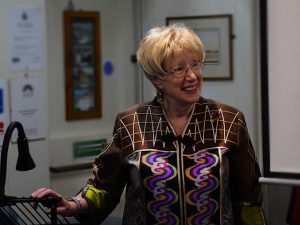Many who attended Ann Rachlin’s riveting performance – The Ménage à Trois in Ellen Terry’s Garden – at Rye Museum on Thursday November 9 – were familiar with the local National Trust attraction of Smallhythe Place and its treasures, such as the restored Ellen Terry costume made from 1,000 beetle wings, and may have gone to plays at the Barn Theatre and admired the Priest House next door.
But everyone in the audience will have learned much more about the woman once regarded as the leading actress of the age and the threesome who did so much to preserve and enhance her legacy – and laughed many times during Ann’s telling. The lead character in the Ménage à Trois was Edy Craig, Ellen Terry’s daughter.
Though the main characters in Ann’s story lived in an age of much stricter declared ideas of “morals” than are current today, the personal lives they lived were much more in tune with what has become permissible in our own times. The father of Ellen Terry’s children – Edith Craig and her younger brother Gordon Craig – was not any of her three husbands but the architect-designer Edward Godwin. (The surname Craig was a kind of defence against the ostracism often meted out to illegitimate children in former times.)
Edith (1869-1947) became a well-regarded costume designer, theatre director/producer and suffragette, and set up the in the lesbian Ménage à Trois in Ellen Terry’s garden at Smallhythe. Her younger brother (1872-1966) became an actor, designer, writer and director of modernist theatre – in the meantime producing 14 children by a variety of women.
After Ellen Terry died, Edy worked on memoirs of her mother’s life and her own part in it. The quarto notebooks containing the memoirs and photos and illustrations were lost for years, then found – and it was Ann Rachlin, MBE, who bought them and in 2011 produced the book Edy Was a Lady, illuminating not only the partnership of her mother and Sir Henry Irving, which gripped audiences everywhere and made Ellen Terry the undisputed leading actress of her day, but the role of daughter Edith and her friends in that life and legacy too.

Ann Rachlin built her reputation as a pioneer of music appreciation for children via public storytelling performances around the world and Fun with Music recordings. (Prince William and Prince Harry attended her classes). She now gives audio-visual presentations for adults and because she lives locally, Rye Museum has been able to take advantage. Thus the wonderful evening of professional storytelling illuminated by rare photos and illustrations from Edy’s colourful collection.
Edy Craig has been called the most extraordinary contributor to British theatre of her time. Besides being illegitimate, a lesbian and an active campaigner for women’s suffrage, she was an actor onstage and in silent movies, a brilliant costume designer and maker, a stage producer, and a fencing expert. Touring the UK and USA with her mother she met other big names of the day such as George Bernard Shaw, Alfred Lord Tennyson and King George V.
The focus of Ann’s talk was the threesome who lived and worked together at Smallhythe and after Ellen Terry’s death in 1928 created the Barn Theatre dedicated to honouring her. Every year the three produced a Shakespeare play to commemorate the anniversary of her mother’s death. They prepared Smallhythe for opening to the public, supported by the National Trust from 1939, and Edy left Smallhythe to the National Trust when she died.
The second member of the Ménage à Trois was Christabel Gertrude Marshall (aka Christopher Marie St John) (1871 –1960), also a suffragette campaigner and also a playwright and author, who was contracted by Ellen Terry to assist with her publications, edited her Memoirs and continued such work after her death and after Edy’s too. She had lived with Edy for 48 years.
The Ménage à Trois was created in 1916 when a third lesbian woman joined Edy and Christabel at Smallhythe. Clare ‘Tony’ Atwood (1866-1962) was a British painter – portraits, landscapes, still life – who was commissioned by the Canadian government and also the Imperial War Museum to paint war scenes. Her paintings are held in prestigious collections in the UK (for example the V&A and the Tate) and abroad. She joined the other two women in 1916. Among their good friends were Radclyffe Hall of Rye and Vita Sackville-West. The ashes of Edith Craig’s two companions are buried at the Smallhythe church but Edith’s have been lost.
There so many good stories about all the characters mentioned above (and more) with neither space nor flair to do them justice here, the best course for interested readers of this report is to ask your organisation to invite Ann to visit you. Oh, and visit/revisit Smallythe too.
Photos: courtesty of National Trust and Rye Museum
Image Credits: courtesy of the National Trust .



